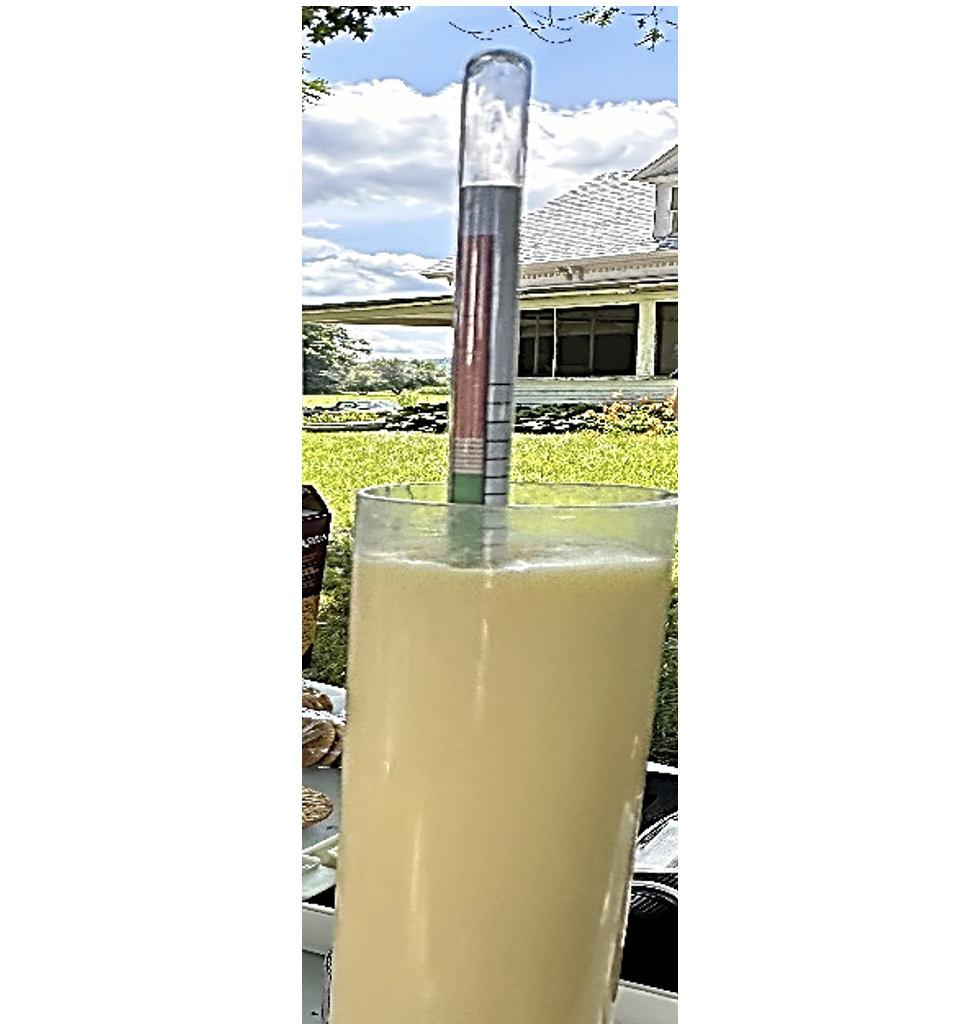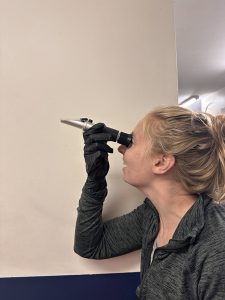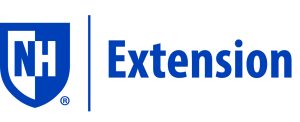Bulletin #1079, Maine Dairy Calf Chronicles: Colostrum Quality and Management
Bulletin #1079, Maine Dairy Calf Chronicles: Colostrum Quality and Management (PDF for printing)
By Glenda Pereira, Ph.D., Assistant Professor and Extension Dairy Specialist, University of Maine Cooperative Extension and Ana Paula Jimenez, Research Assistant, University of Maine.
Reviewed by Sarah Allen, Extension State Specialist, Dairy Production, University of New Hampshire, Peter Erickson, Dairy Production State Specialist, University of New Hampshire, and Toyin Osuolale, University of New Hampshire.
For information about UMaine Extension programs and resources, visit extension.umaine.edu.
Find more of our publications and books at extension.umaine.edu/publications/.
Introduction
This bulletin highlights how focusing on colostrum harvest, post-harvest management, and measuring colostrum quality will help set your calves up for success. We recommend making storing high-quality colostrum on your farm a priority in case dams can’t produce colostrum. A recent study reported that 2.65% of the Jersey cows enrolled could not produce any colostrum. Calf success must result from enforcing best management practices, vaccination, biosecurity, and cleaning protocols. If you still have concerns about your colostrum management, consider blood testing your calves for antibody levels.
Colostrum is the first milk produced by a dam right after birth and contains antibodies and nutrients that support the newborn calf’s immune system and help with growth development. Calves are born with naïve immune systems because maternal antibodies, like immunoglobulin G (IgG), are unable to cross the placenta. Therefore, dairy calves must get enough high-quality colostrum as soon as possible after birth to obtain passive immunity and reduce the risk of morbidity and mortality in the preweaning period. Ideally, colostrum should be fed within 2 hours, but colostrum absolutely must be fed within 24 hours. This is critical because the gut wall of the calf starts maturing, resulting in decreased absorption of larger proteins. From an economic perspective, calves that are fed enough colostrum are more profitable. Previous research indicated that Brown Swiss calves fed four quarts of colostrum had lower veterinary costs, grew 29% faster, and produced 11% more milk during the first lactation, and 17% more during the second lactation compared with calves that were only fed two quarts of colostrum.
Antibodies – Proteins that can recognize and eliminate pathogens. Immunoglobulin G (IgG) is the most common antibody, and it protects against bacterial and viral infections. Measured in g/L or mg/mL.
Colostrum harvest
Sanitize your colostrum harvesting equipment and use stainless steel colostrum harvesting equipment to reduce the chances of bacterial growth. Some service providers have ATP meters which can help measure the organic matter present on the surface of colostrum feeding bottles and harvesting buckets. Implementing an acid-based wash will help remove milk solids residue and ensure clean feeding equipment between calves.
Measuring colostrum quality
Feeding low-quality colostrum is ineffective; therefore, it is recommended to test colostrum from all cows and store any colostrum from dams that have higher quality. Colostrum quality is not impacted by lactation number, and high-quality colostrum from primiparous cows should be fed.
If your colostrum must be discarded, if cows are not producing enough colostrum, or if you have disease transmission concerns (such as Johnes) you should use a lacteal-based colostrum replacer.
Below are two methods that can help assess colostrum quality on farms.
Colostrometer – a hydrometer with a color-coded scale that measures specific gravity calibrated in milligrams per milliliter (mg/mL) of IgG. We also measure in g/L. To use, place the colostrometer into a cylinder containing room temperature colostrum (72° F). If the colostrum is not the correct temperature, you may over or underestimate the IgG concentration.
Table 1: Color-code interpretation for colostrometer.
| Color-Code | Interpretation |
|---|---|
| Green | >50 g/L of IgG |
| Yellow | 20 to 50 g/L of IgG |
| Red | <20 g/L of IgG |

Brix refractometer – measures the amount of sucrose in colostrum as well as total solids. The brix values are expressed in percentages, and a value of 22% corresponds to 50 g/L of IgG which indicates excellent quality colostrum. Colostrum that tests with values below 18% should be discarded. To use a refractor follow the instructions below:
- Calibrate it and put 2–3 drops of colostrum on the glass surface.
- Lower the cover over the sample so the milk spreads across the entire surface without any air bubbles or dry spots.
- Wait 15 seconds before taking a reading –the sample adjusts to room temperature.
- Hold the refractometer up to natural light while looking down at the eyepiece. Avoid fluorescent light sources.
- As you look down at the eyepiece (shown in the photo), you will see a circular field with graduations down the center. The scale should read zero where the light and dark areas meet. If not, adjust using the calibration screw.
- Read the brix value of the colostrum sample.

Colostrum post-harvest and storage
- Consider a pre-chilling method such as an ice bath before storing the colostrum in a refrigerator or freezer to quickly cool down the colostrum after harvest.
- Colostrum can be stored in a clean refrigerator (at least 40°F to slow down bacterial growth) and can be refrigerated for 4-6 days.
- Freeze colostrum immediately after harvesting or pre-chilling if you are not feeding it soon. Use clean bottles or bags and label the colostrum containers with cow ID, date of collection, and state the IgG level or some indicator of colostrum quality. Storage temperatures should be -5°F. Colostrum can be frozen for up to a year with minimal loss in quality (best if used by 6 months).
- Effectively storing colostrum is important to maintain lower levels of bacteria in milk fed to calves. Spot checking colostrum bacterial counts may help pinpoint areas of opportunity.
Feeding
- Optimal colostrum feeding temperature is 102°F (range 100 to 106°F). Consider where you are warming and where/when you are feeding so the temperature doesn’t drop drastically.
- Feed fresh colostrum within one-half hour after it is harvested.
- Frozen colostrum should be thawed slowly, and the temperature of the water should not reach above 140° F, as the absorption of antibodies by the calf will be compromised. Use a thermometer or a controlled warming unit such as a water bath. If using a water bath, set temperature between 120 to 125 degrees F for at least 30 minutes.
- Refrigerated colostrum should be slowly heated at 105 to 110°F for at least 15 minutes.
Summary
The “3 Qs” of colostrum are critical for newborn calves’ health and their success as a future lactating dairy cow. Quantity- calves need to drink at least 10% of their body weight in colostrum to receive essential nutrients and passive immunity. Quality- colostrum should contain at least 50 g/L of IgG to obtain passive immunity. Quickly– colostrum should be fed right away (ideally within 2 hours) to ensure absorption of IgG.
References
- AHDB dairy (2015). The 3 Q’s of feeding colostrum: Quantity, Quality, and Quickly. https://projectblue.blob.core.windows.net/media/Default/Imported%20Publication%20Docs/3%20Qs%20of%20feeding%20colostrum%20quantity%20quality%20and%20quickly.pdf
- Cullens F. 2017. Storing colostrum. Michigan State University Extension. canr.msu.edu/news/storing_colostrum#:~:text=Consider%20pre%2Dchilling%20the%20colostrum,vaccines%20stored%20in%20the%20fridge.
- Devery, J. E., Davis, C. L., & Larson, B. L. (1979). Endogenous production of immunoglobulin lgG1 in newborn calves. Journal of Dairy Science, 62(11), 1814–1818. https://doi.org/10.3168/jds.s0022-0302(79)83504-3
- Faber, S., Faber, N., McCauley, T., & Ax, R. L. (2005, October). CASE STUDY: Effects of colostrum ingestion on lactational Performance1. Professional Animal Scientist, 21(5), 420–425.
- Geiger, A. J. (2020). Colostrum: back to basics with immunoglobulins. Journal of Animal Science, 98(Supplement_1), S126–S132. https://doi.org/10.1093/jas/skaa142
- Gelsinger, S. L., Gray, S. M., Jones, C. M., & Heinrichs, A. J. (2014). Heat treatment of colostrum increases immunoglobulin G absorption efficiency in high-, medium-, and low-quality colostrum. Journal of Dairy Science, 97(4), 2355–2360. https://doi.org/10.3168/jds.2013-7374
- Gelsinger, S. L., Jones, C. M., & Heinrichs, A. J. (2015). Effect of colostrum heat treatment and bacterial population on immunoglobulin G absorption and health of neonatal calves. Journal of Dairy Science, 98(7), 4640–4645. https://doi.org/10.3168/jds.2014-8790
- Heinrichs, J., and C. M. Jones. 2022. Composition and Hygiene of Colostrum on Modern Pennsylvania Dairy Farms. extension.psu.edu/composition-and-hygiene-of-colostrum-on-modern-pennsylvania-dairy-farms
- Heinrichs, J., and C. M. Jones. 2023. Colostrum management tools: Hydrometers and refractometers. Psu.edu. https://extension.psu.edu/colostrum-management-tools-hydrometers-and-refractometers
- Huston, C. L. (2015). Colostrum and the Newborn Calf. Msstate.edu. extension.msstate.edu/sites/default/files/topic-files/cattle-business-mississippi-articles/cattle-business-mississippi-articles-landing-page/vet_feb2015.pd
- Malacco, V. (n.d.). Harvesting and storing colostrum: Tips for success. Dairy. Retrieved January 26, 2024, from https://www.canr.msu.edu/resources/harvesting-and-storing-colostrum-tips-for-success
- Phipps, A. J., Beggs, D. S., Murray, A. J., Mansell, P. D., Stevenson, M. A., & Pyman, M. F. (2016). Survey of bovine colostrum quality and hygiene on northern Victorian dairy farms. Journal of Dairy Science, 99(11), 8981–8990. https://doi.org/10.3168/jds.2016-11200
- Playford, R. J., & Weiser, M. J. (2021). Bovine colostrum: Its constituents and uses. Nutrients, 13(1), 265. https://doi.org/10.3390/nu13010265
- Rabaza, A., Fraga, M., Mendoza, A., & Giannitti, F. (2023). A meta-analysis of the effects of colostrum heat treatment on colostral viscosity, immunoglobulin G concentration, and the transfer of passive immunity in newborn dairy calves. Journal of Dairy Science, 106(10), 7203–7219. https://doi.org/10.3168/jds.2022-22555
- Rankin, S. A., Bradley, R. L., Miller, G., & Mildenhall, K. B. (2017). A 100-Year Review: A century of dairy processing advancements—Pasteurization, cleaning and sanitation, and sanitary equipment design. Journal of Dairy Science, 100(12), 9903–9915. https://doi.org/10.3168/jds.2017-13187
- Robbers, L., Jorritsma, R., Nielen, M., & Koets, A. (2021). A scoping review of on-farm colostrum management practices for optimal transfer of immunity in dairy calves. Frontiers in Veterinary Science, 8. https://doi.org/10.3389/fvets.2021.668639
- Sanguesa, P. B. (2022). Harvesting and storing colostrum: Tips for success. Dairy. Retrieved June 30, 2024, from https://www.canr.msu.edu/resources/harvesting-and-storing-colostrum-tips-for-success
- Stahl, T.C., E.M. Mullin, J.M. Piñeiro, M. Lunak, M. Chahine, P.S. Erickson. 2024. Creating models for the prediction of colostrum quantity, quality, and immunoglobulin G yield in multiparous Jersey cows from performance in the previous lactation and environmental changes. 107: 7, 4855-4870. https://doi.org/10.3168/jds.2023-24209
- Using a Brix refractometer. (n.d.). Org.uk. Retrieved January 25, 2024, from https://ahdb.org.uk/knowledge-library/using-a-brix-refractometer

Project funding by Northeast Dairy Business Innovation Center.
Information in this publication is provided purely for educational purposes. No responsibility is assumed for any problems associated with the use of products or services mentioned. No endorsement of products or companies is intended, nor is criticism of unnamed products or companies implied.
© 2024
Call 800.287.0274 (in Maine), or 207.581.3188, for information on publications and program offerings from University of Maine Cooperative Extension, or visit extension.umaine.edu.
In complying with the letter and spirit of applicable laws and pursuing its own goals of diversity, the University of Maine System does not discriminate on the grounds of race, color, religion, sex, sexual orientation, transgender status, gender, gender identity or expression, ethnicity, national origin, citizenship status, familial status, ancestry, age, disability physical or mental, genetic information, or veterans or military status in employment, education, and all other programs and activities. The University provides reasonable accommodations to qualified individuals with disabilities upon request. The following person has been designated to handle inquiries regarding non-discrimination policies: Director of Equal Opportunity and Title IX Services, 5713 Chadbourne Hall, Room 412, University of Maine, Orono, ME 04469-5713, 207.581.1226, TTY 711 (Maine Relay System).

